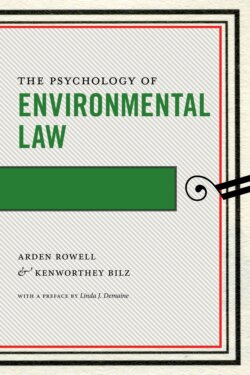Читать книгу The Psychology of Environmental Law - Arden Rowell - Страница 25
На сайте Литреса книга снята с продажи.
2 Diffusion
ОглавлениеThe environmental consequences of human behaviors are often both literally and psychologically distant from the human actions that caused them. In this chapter, we present research in psychology to explain how and why effects that are diffuse through space and/or time are so hard for people to perceive, respond to, and appreciate. The cognitive and emotional barriers people face in addressing diffuse environmental impacts have profound implications both for how environmental law operates and for how it might be made more effective.
Diffuse environmental injuries pose a particular problem for environmental law. Regulations that have little obvious or immediate beneficial effects on individual citizens might have large effects in distant places or on future generations. Consider an example of diffusion across time: Exposure to a carcinogenic pollutant such as arsenic, asbestos, or benzene is likely to cause cancer (if it causes cancer at all) years, if not decades, in the future (Revesz, 1999). Or an example of diffusion across space: Air pollution routinely drifts across state borders. On certain days, the EPA estimates that as much as a quarter of the particulate matter air pollution above Los Angeles was emitted in China (Lin et al., 2014). And as example of both kinds of diffusion simultaneously, consider that most of the harms of climate change are expected to accrue to future generations (Revesz & Shahabian, 2011) in foreign lands (Rowell, 2015; Rowell & Wexler, 2014). Indeed, as we discuss in our chapter on climate change, the failure of environmental law to effectively and comprehensively deal with climate change may in no small part be explained by the diffuse nature of climate injuries, and the psychological obstacles that diffusion presents.
In other words, there is often a physical distance, temporal distance, or both, between a behavior the law might seek to regulate and the apparent effects of that behavior. This can make it difficult for both policy makers and citizens to connect behavioral causes with environmental effects. Even when people take on the complex cognitive cost of tracking down the relationship between behavior and impact, they may find that the environmental benefits of behavioral change would accrue to future or distant others rather than to themselves. Particularly where diffuse environmental impacts must be traded off against more prominent cognitive considerations—such as immediate and proximate cost, convenience, security, or aesthetics—the cognitive distance of environmental impacts tends to make them fade into the background.
This chapter proceeds by first discussing the general phenomenon of diffuse impacts, focusing on the psychology of externalities. Next, the chapter explores the cognitive and emotional/motivational phenomena that are likely to affect the way that people perceive, process, and respond to diffuse environmental impacts.
